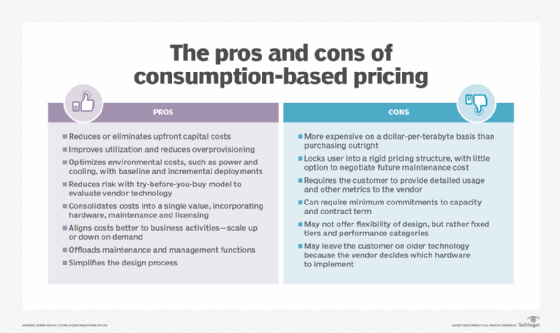What is a consumption-based pricing model?
A consumption-based pricing model is a service provision and payment scheme in which customers pay according to the resources they use. The charges are based on one or more metrics that are measured in units such as the number of application programming interface (API) calls or the amount of storage used. The provider tracks how many units their customers use and then bills them for the amount of services consumed.
Consumption-based pricing — also referred to as pay-as-you-go billing, metered billing or usage-based pricing — is relatively new to computing. However, this approach is common in many traditional business types. For example, municipal utility companies, such as water or electricity services, charge consumers a fee based on the amount of resources they’ve used. They might include a base service fee as well, but the bulk of the charges typically follow a consumption-based pricing model.
Consumption-based pricing is common in cloud computing and utility computing. Such services are often treated as commodities that make it possible to rapidly deploy workloads, as well as scale up or down based on demand. Platform as a service (PaaS) and infrastructure as a service (IaaS) often use consumption-based pricing to maintain a cost advantage and profitability, although this model has also made significant inroads into the software as a service (SaaS) market.
Consumption-based pricing is often used in place of a subscription pricing model. With subscriptions, customers pay the same amount for access to a service regardless of how much or how little they use it. An example of a subscription service is cable television, where customers pay the same amount per month no matter how much TV they watch.
Vendors have traditionally offered their software products as one-time purchases or as subscriptions. With the emergence of SaaS, however, vendors are increasingly applying the consumption-based model to their products.
Common consumption-based pricing models
Consumption-based pricing tracks and bills how much a service or product is used, based on one or more metric units. The exact details of what is tracked can vary from product to product and provider to provider. Often charges are quantitated by factors such as time used, resources consumed or number of active users.
Providers might offer a certain amount of use for free, while others require a minimum commitment. Some providers might track and bill for services based on multiple factors, which can sometimes make the total bill difficult for customers to predict. The following pricing models demonstrate some of the more common approaches that vendors take:
- Pay-as-you-go. Although consumption-based pricing is sometimes called a pay-as-you-go model, this term can also refer to a pricing model in which customers simply pay on a per-unit basis according to their actual usage, no matter how many units they consume. Payments are made in arrears (after the fact), once the number of units has been calculated.
- Tiered. Pricing is based on a tiered structure according to specific usage thresholds, such as the number of users or the amount of data consumed. Customers who exceed a threshold are usually bumped up to the next tier automatically. In this model, the lowest tier might be offered for free.
- Volume. Pricing is based on a volume usage metric, such as API calls or the amount of data consumed. The units are grouped into payment tiers that contain increasingly higher ranges of units. As the number of units in a package grows, the price-per-unit drops, providing customers with an incentive to use more units.
- Overage. The service is sold in packages that specify the maximum number of service units that are included, such as the total number of gigabytes permitted in a data plan. Customers who go over the package’s threshold are charged an overage fee for number of units that exceed the threshold.
- Hybrid. The vendor combines usage-based pricing with traditional subscription-based pricing to provide a more flexible pricing model. The hybrid model has been growing increasingly popular with SaaS providers because it helps address some of the challenges with either approach alone, although it often comes with increased billing complexity.
These are by no means the only approaches that providers are taking when adopting a consumption-based pricing model. They might also combine multiple strategies. For example, a vendor might combine tiered pricing with overage pricing to provide customers with the ability to purchase units if they exceed the top-level tier.
Vendors might also base charges on multiple metrics, require a minimum commitment from their customers, require customers to prepay for their services, or take other approaches. There is no one standard for how service providers should approach consumption-based pricing.
Common consumption billing items
Vendors use different metrics for billing their customers, depending on the nature of the service. They might also mix metrics or offer their customers multiple options. The following metrics are some of the more common units that providers use:
- Resource consumption. This means measuring resources consumed over a period of time. For example, vendors might charge for the number of processor cores used in an hour, the length of time a virtual machine was active, or how many milliseconds it took the service to handle a customer request.
- Data transfer. This refers to gigabytes of data transferred to or from the provider’s platform during ingress or egress operations.
- Data storage. This metric measures gigabytes of data stored on the provider’s platform.
- Uses. Uses or queries refers to the number of times a customer accesses the provider’s API. The vendor might bill the customer for individual API calls or bill them in groups, up to a specified amount, such as 100,000.
- Execution memory. This approach measures gigabytes of RAM per second consumed by the customer’s workloads and is common in serverless functions.
- Credits. Prepaid amount for the service, based on one or more metrics defined by the provider. Credits are often specialized and based on workloads.
- Usage. Software charges are based on specific uses. For example, charges for customer relationship management software might be based on the number of customer contacts held in the system.
Advantages of consumption-based pricing as a customer
Consumption-based pricing is increasingly attractive for customers because it provides them with more flexibility and better ties their costs to the value received. If the product is a cloud-based service, customers also avoid the capital expenditures that come with building their own systems. These savings can be especially beneficial to smaller organizations, startups or even departments in larger organizations. Vendors are also highly motivated to assist customers in getting the most out of their services, so customer service is often better.
Many cloud service providers now offer some form of consumption-based pricing. Cloud services offer customers more flexibility in responding to market trends and fluctuating demands. Customers pay only for the services they consume, rather than tying up capital in traditional subscriptions or hardware. They also pay only a single bill, which is simpler than managing hardware, software and other service costs separately.
The advantages of a consumption-based pricing model can be summed up as follows:
- Reduced capital and maintenance costs.
- Less waste and overprovisioning.
- Incentivized vendor support.
- Lower ecological impact due to vendor economies of scale.
- Fewer startup risks.
- Consolidated billing.
- Faster and easier scaling.
- Simpler system design.

Disadvantages of consumption-based pricing as a customer
Despite the advantages of consumption-based pricing, customers also face a number of challenges:
- For some customers, particularly larger organizations, consumption-based pricing might be more expensive than purchasing and building their own systems. Organizations should conduct a total cost of ownership analysis before choosing one approach over the other.
- Depending on the type of service, pricing structure and workloads, customers might find it difficult to predict their billing totals and could be caught off-guard by the service fees.
- Customers could see massive bills as a result of their wasted or non-critical activity, such as testing or trying out systems. In addition, a misconfiguration in the customer implementation could rack up billing without any useful benefits.
- Customers could experience vendor lock-in, making it difficult to switch providers.
- Customers might have to contend with rigid pricing structures, without any say in vendor service quality.
Consumption-based pricing as a provider
Many service providers have moved from subscription-based pricing to a consumption-based model. Some offer both pricing models, while others are considering various consumption-based options. SaaS providers in particular have shown a growing interest in adopting consumption-based pricing for their services. Service providers are increasingly using cloud services themselves, in which case consumption-based pricing can help them align their customer billing and provider costs more accurately.
Consumption-based pricing models often lead to better customer retention and revenue than a subscription-only model. Consumption-based pricing also provides customer-use metrics that help to determine where to expand and improve. In addition, vendors who offer consumption-based pricing often have a competitive edge over those who don’t because many customers prefer this approach. Even investors have begun to take notice of vendors that offer some form of consumption-based pricing.
Learn how flexible consumption models lower IT overhead, help investments and why pay-per-use pricing models can boost digital initiatives. Explore the consumption-based IT and Opex storage landscape, eight ways to reduce cloud costs and how to calculate cloud total cost of ownership. Check out top four data storage trends including consumption-based pricing.













